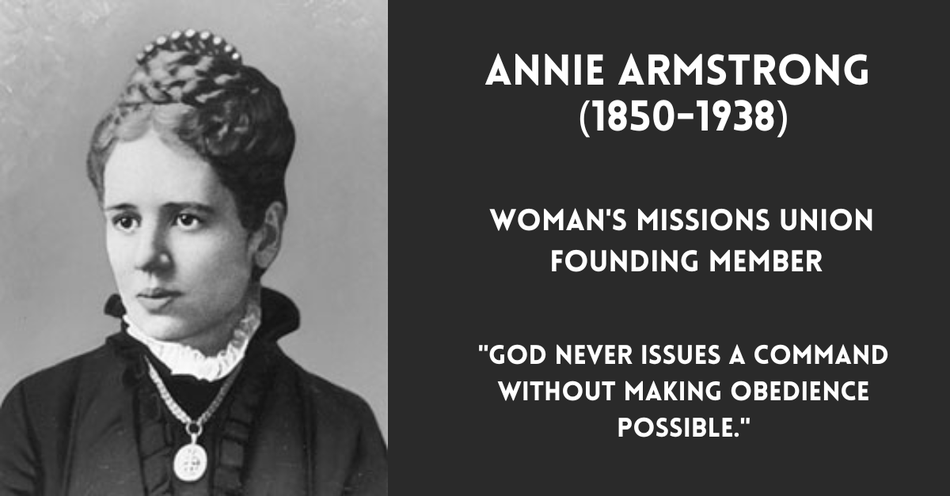Annie Armstrong was a woman of fortitude with a gifted ability to lead, organize, and motivate others to press forward in mission work and giving. She is known for writing thousands of letters detailing mission endeavors and raising money for home and foreign missionaries.
Why You Should Remember Annie Armstrong
If you dig through the archives regarding pictures of Annie Armstrong, you will only find the one shown above. In the book Go Forward, Cathy Butler states that whenever someone asked to take her photo, Annie replied, “Thank you, but I do not have my picture taken. What if some man found a copy of it and took it into a saloon? A woman should be spared the humiliation of such public stares, even in print.”
The real reason originated at the Home of the Friendless Christmas party. Annie had arranged a special stereopticon (projector for transparent slides) presentation for the children. While the children were watching the “magic lantern” show, Annie excused herself to have a portrait made for a particular missionary gentleman. She planned to pick it up later.
Instead, the picture of her in a high-collared dress with a lace ruffle and locket on a chain made its way into the slide show. A friend placed it there as a joke. Annie was embarrassed and mortified. From that day forward, she vowed never to have her picture taken again.
Who Was Annie Armstrong?
Annie Walker Armstrong was the third daughter and fourth child born to Mary and James Armstrong on a sizzling hot day, July 11, 1850. Mary Elizabeth (Mamie), Alice, James John, and William were her siblings. Her older sisters (especially Alice) would later work with her in missions.
In 1852, James Armstrong died at 48, leaving Mary with four young children and another baby on the way. In the following years, Mary, a strong Christian with a godly heritage, dedicated herself to raising her children in the admonition of the Lord and attending the Seventh Baptist Church.
In 1870, Annie, Alice, and their mother were listening to a sermon by pastor Dr. Richard Fuller (also president of the Southern Baptist Convention) at Seventh Baptist Church. That day, Annie Armstrong heard Dr. Fuller say, “The religion of Jesus Christ gives peace in the midst of trouble.”
Annie realized she had been searching for peace that only came through Jesus Christ. She believed and placed her faith in Jesus. She was baptized in December 1870. The following year, she and her mother and her sister Alice decided to become charter members of Eutaw Place Baptist Church. Dr. Fuller also became a charter member and its pastor.
The opportunity to serve was great. The three women flourished in service through The Working Society. Mary served as the first president, while Annie and Alice helped in various ministry endeavors.
In 1872, “a mite box” was given to Ellen Edwards, who had recently visited at a Baltimore mission society meeting. She returned to South Carolina with several boxes with Bible verses and the words “To give light to them that sit in darkness” and “Woman’s Gospel Mission to Woman in Foreign Land” written on the sides in gold. Women were challenged to place two cents in the box each week. Today, the mite box is called a missions box, and they are often used with children to encourage giving to missions.
Annie Armstrong’s life provides many stories about God working through people and circumstances to build the Woman’s Missionary Union. Annie also played a key role in raising money for Home Mission Board (now the North American Mission Board) and the Foreign Mission Board (now the International Mission Board).
Church involvement in missions took on a new path with the inception of the Woman’s Missionary Union (WMU). On May 14, 1888, Annie Armstrong was elected the first corresponding secretary (now executive director and treasurer). The WMU headquarters were in Baltimore, Maryland. She and her sister, Alice, wrote the constitution and bylaws. Her goal was to promote mission education and fundraising through local church involvement. She retired in 1906.
Annie never accepted a salary in her 18 years as corresponding secretary, based upon 2 Samuel 24:24 (“that which costs me nothing.”) but did receive travel reimbursement in the last few years of her tenure. Her motto or watchword was, Go Forward. The word forward was so significant to her that it appeared in most of her annual reports.
Known as a gifted businesswoman, leader, organizer, communicator, and motivator, she dedicated her abilities and gifts to fulfill her God-given call. Yet, sometimes in her service, she was also known as demanding and thin-skinned. Fannie Heck (also known for her immense WMU work and writing) and Annie did not see eye-to-eye, yet they worked together to further missions and serve missionaries.
10 Events in the Life of Annie Armstrong
1. Throughout her life, Annie was a prolific writer. She wrote mission columns for newspapers and magazines, curriculum for classes and mission meetings, and leaflets for WMU. Some publications include the Baltimore Baptist, Foreign Mission Journal, The Religious Herald of Virginia, and Our Home Field.
2. Letter-writing was at the top of her mission work. The letters written in 1893 totaled 17,718 and were sent to missionaries, women, pastors, and leaders with the state and national Southern Baptist Convention. It is estimated that she wrote an average of 600 letters per month.
3. Annie Armstrong taught for years in the Infant class for 50 years. But don’t let the name sway you; it was for children up to age 12, also called the Primary Department.
4. The Missionary Library and Reading Room was established in 1886. It was based above the Wharton and Barron Publishing Company, which offered the space rent-free. However, because the women could not climb the inside ladder to reach the upper room, funds had to be raised for an outside stairway. The reading rooms opened in March 1888, along with a library. Missions literature became available to order across the United States and Canada.
5. Annie started the Ladies’ Bay View Mission; she served on the board of managers for the Home of the Friendless for over 20 years. In 1880, The Woman’s Baptist Home Mission Society of Maryland asked her to serve as the organization’s first president.
6. Annie Armstrong initiated fundraising to help Lottie Moon return to the United States on furlough. The goal was to raise money for two missionaries. The offering was so successful they sent three female missionaries to China, providing a much-deserved break for Lottie Moon for the first time in eleven years.
7. At the recommendation of Annie Armstrong, The Lottie Moon Christmas Offering for Missions was named in honor of Lottie Moon.
8. In 1934, The annual Easter Home Missions Offering was renamed The Annie Armstrong Easter Offering in her honor.
9. Other mission activities Anne was involved with: work with African Americans, Native Americans, mountain people, internationals, and packages shipped to missionaries and Cuba.
10. Armstrong died on December 20, 1938, and was buried at Greenmount Cemetery in Baltimore. On her grave marker are words from one of her notebooks: “She hath done what she could.”
5 Tidbits You Didn’t Know About Annie Armstrong
1. “Strong Arm” was one of several nicknames for Annie, and she was known as “the Mastermind Behind WMU.”
2. Within the Southern Baptist Denomination, she was called “indefatigable.” Later, the pastor emeritus, John Roberts, of the Eutaw Place Baptist Church (now Woodbrook Baptist Church) called her “indomitable.”
3. Annie Armstrong promoted a systematic proportioned giving plan based on Malachi 3:10.
4. Armstrong created and launched the Annuity Plan in 1901 through WMU, assisting all three convention boards.
5. After she retired from WMU, she remained active in multiple missions ministries.
Quotes by Annie Armstrong
“God is bringing the nations of the world to America. By helping home missions, the foreign supply is increased. The need for chapels and other aid, especially on the frontier, is immediate and distressing.” Go Forward: The Story of Annie Armstrong
“Knowledge is power, interest, and inspiration.” — Go Forward
“The future lies all before us … shall it only be a slight advance upon what we usually do? Ought it not to be a bound, a leap forward to altitudes of endeavor and success undreamed of before?” — “On Mission for God: Annie Armstrong’s Easter Story”
“Oh, Mother, I could never be anything but a Baptist.” — Go Forward
“‘God never issues a command without making obedience possible,” Annie wrote. ‘Let us advance on our knees.’” — We’ve a Story to Tell: 125 Years of WMU
“Rewards await us yonder, work awaits us here.” — Go Forward
“Christ’s work is best known by the character of its workers.” — We’ve a Story to Tell
“‘Speak unto the children of Israel that they go forward’... After study of God’s Word comes the study of the fields. Then people pray. Then they give.” — message by Armstrong to the WMU Golden Jubilee in 1938, quoted in WMU brochure The Life of Annie Armstrong
Additional Reading About Annie Armstrong
Go Forward: The Story of Annie Armstrong by Cathy Butler
Rescue the Perishing: A. Armstrong by Keith Harper
Miss Annie’s Secret: The story of Annie Armstrong by Jimmye Winter
Annie Armstrong: Dreamer in Action by Bobbie Sorrill
Miss Strong Arm: The Story of Annie Armstrong by Jacqueline Durham
Annie Armstrong edited by Nan F. Weeks
We’ve a Story to Tell, 125 Years of WMU, by Rosalie Hall Hunt
Photo Credit: Public domain photo via Wikimedia Commons
Laura Lee Leathers is a writer and speaker. Imagine Lois Lane, over sixty-five, and living on a farm. Her metropolis is the area of freelance writing. Her primary love interest is the Word of God. She digs for information, interviews fascinating people, offers a cup of biblical hospitalit-tea, encourages, and helps others with the ‘how-to’s’ of life. To sign up for her newsletter, connect with her at http://lauraleeleathers.com - - - “Helping You Flourish in Faith & Finish Well by His Word”
This article is part of our People of Christianity catalog that features the stories, meaning, and significance of well-known people from the Bible and history. Here are some of the most popular articles for knowing important figures in Christianity:
How Did the Apostle Paul Die?
Who are the Nicolaitans in Revelation?
Who Was Deborah in the Bible?
Who Was Moses in the Bible?
King Solomon's Story in the Bible
Who Was Lot's Wife in the Bible?
Who Was Jezebel in the Bible?
Who Was the Prodigal Son?


.png)
